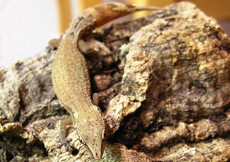Ebenavia inunguis
(BOETTGER, 1878)
Distribution:
East and north of Madagascar, Mauritius, Comoros (SCHÖNECKER, 2008)
Description:
Ebenavia inunguis females reach a total maximum length of 8 centimeters, half of which is attributable to their tail. Males are about 0.5 centimeters smaller than females. The head is remarkably pointed and their body is covered in fine granules with scattered tubercles. Their toes have adhesive disks. They have slit-shaped pupils, which is a perfect characterization of their nocturnal and crepuscular nature. Coloration does not differ between sexes. Dorsally Ebenavia inunguis is brown with a paler dorsolateral stripe that runs from the tip of the snout to their back legs. This stripe may be more or less pronounced depending on the gecko's origin. For example the stripe of the animals found in Nosy Mangabey goes right to the end of their tail. The tail comes to a point at the tip and original tails have black and white banding over the entire tail. Regenerated tails are thickened and orange. The ventral coloration of Ebenavia inunguis is light brown.
In addition to the coloration differences found in different populations, the overall length has shown to be different. Whether or not these populations are actually different species or subspecies has yet to be determined.
Habitat:
Ebenavia inunguis seems to be very adaptable in nature and therefore inhabits both primary rain forests and secondary forests. Some members of this species can be found synanthropic in large numbers in huts and gardens, (Wolf, 2008). It is predominantly an arboreal gecko, hiding during the day under the bark of trees, dead wood, Pandanus and Ravenala (GLAW & VENCE, 2008), which spends their nights in search of food.
Husbandry and Breeding:
Keeping Ebenavia inunguis is relatively simple due to their adaptability. A terrarium with an edge length of 30 centimeters is perfect for a pair. Group housing with one male and a few females is also possible in a larger terrarium. (Schoenecker, 2008). I have also found keeping two males together to be problem free (Dennis Hluschi). The substrate should be a soil/sand mixture in a ratio of 2:1. The humidity should be kept at 70% which is easily maintained by misting the terrarium once daily, the substrate should be kept slightly damp at all times. A dry area should always be offered as well in the terrarium. The back and side walls can be covered with natural cork to increase the usable surface area of the terrarium. Pieces of cork bark are placed on the substrate and placed upright against the walls to offer the geckos a place to hide. Live plants should not be overlooked. Suitable Madagascan plant species such as Medinilla sedifolia, Kalanchoe uniflora and Madagascan Selaginella fissidantoides. Orchids of the genus Aerangis, Bulbophyllum and Angreacum may also be used. A small water dish, as well as a small bowl of crushed up cuttlefish bone completes the decor. The terrarium is illuminated and heated by a fluorescent tube which should be kept on for 12 hours daily in summer, and 10 hours daily in winter. Daily temperatures should be between 26-28°C (79-82°F), with a nighttime drop to around 22°C (72°F) in the summer and 18°C (64°F) in winter. If these temperatures cannot be met a heating pad or heating cable can be placed under the front ventilation area. They should be fed with appropriately sized insects and arthropods, which should always be dusted with a vitamin-mineral mixture.
Although it is very easy to keep this species in captivity, breeding can sometimes pose a problem as they breed very sporadically. Most eggs come only from gravid wild caught females who lay their double eggs (sometimes only one) in captivity and only very rarely will they lay in the terrarium thereafter. The hatchlings are very tiny and rely on very small micro food, such as springtails and micro crickets.
Ebenavia inunguis are fascinating terrarium subjects due to their slow creeping movement. Keeping these geckos is quite simple, however many of the ones available are wild caught and thus in poor condition and will require some nursing with high quality food to get them back in to top health.
Literature:
- Glaw, F & M. Vences (2008): A Field Guide to the Amphibians and Reptiles of Madagascar.
- Schönecker, P. (2008): Geckos of Madagascar.
- Wolf, S. (2008): Die Herpetofauna eines Küstenwaldes bei Cap Est, Nordost-Madagaskar. Terraria 12 (07/08 2008).






